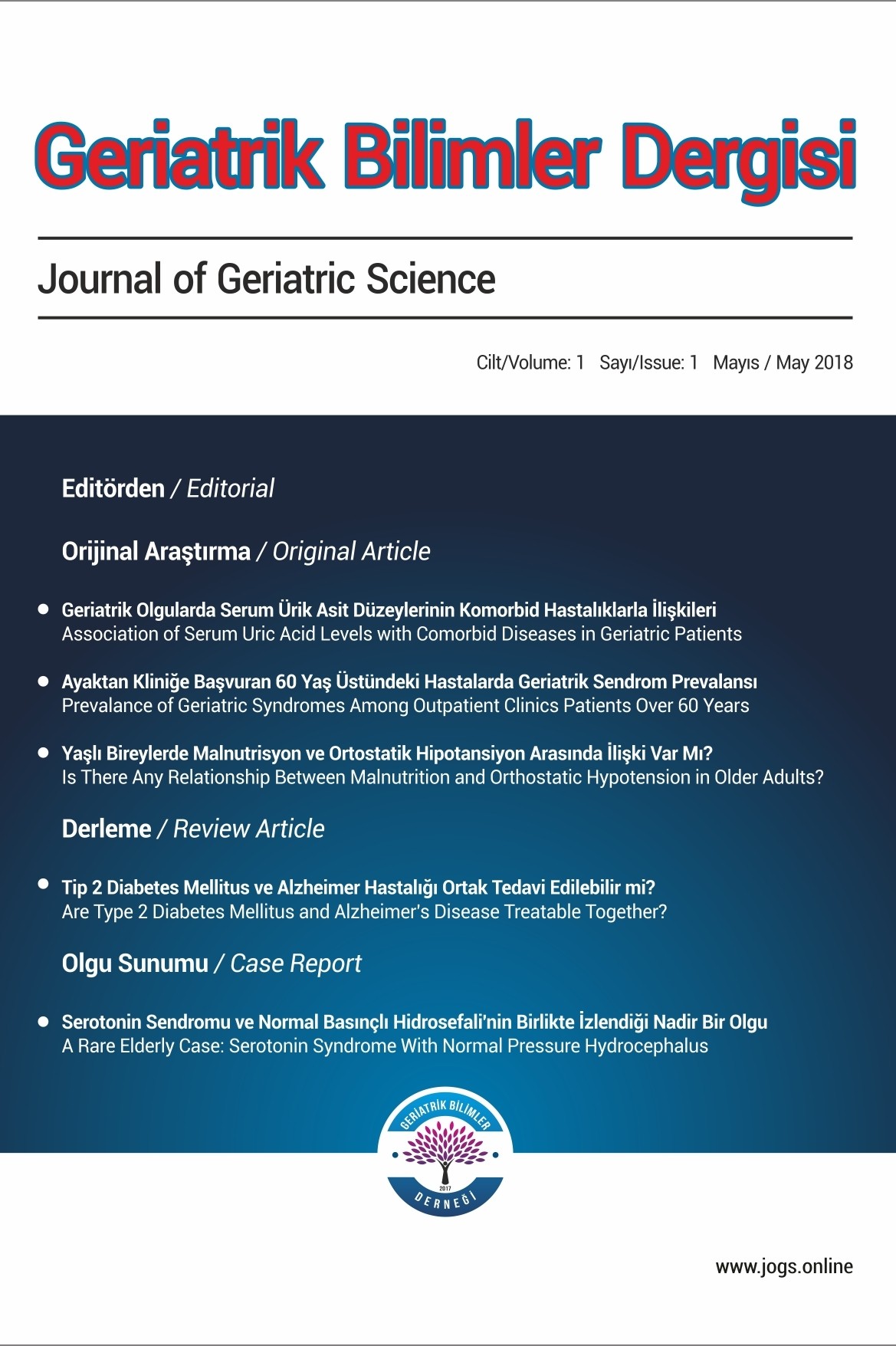Yaşlılarda Düşük Yürüme Hızının Mini Nutrisyonel Değerlendirme ile İlişkisi
yürüme hızı, malnütrisyon, 4 metre yürüme testi, geriatrik sendrom, yaşlı
Relation of Low Walking Speed with Mini Nutritional Assessment in Elderly Patients
Walking speed, 4 meter walking test, malnutrition, geriatric syndromes, elderly,
___
- 1. Ronthal, Michael. "Gait Disorders and Falls in the Elderly." The Medical clinics of North America 103.2 (2019): 203-213.
- 2. Cohen, Jason A., Joe Verghese, and Jessica L. Zwerling. "Cognition and gait in older people." Maturitas 93 (2016): 73-77.
- 3. Binotto, Maria Angélica, Maria Helena Lenardt, and María del Carmen Rodríguez-Martínez. "Physical frailty and gait speed in community elderly: a systematic review." Revista da Escola de Enfermagem da USP 52 (2018).
- 4. Cruz-Jentoft, Alfonso J., et al. "Writing Group for the European Working Group on Sarcopenia in Older People 2 (EWGSOP2), and the Extended Group for EWGSOP2. Sarcopenia: revised European consensus on definition and diagnosis." Age Ageing 48.1 (2019): 16-31.
- 5. Fried, L. P. "Frailty in Older Adults: Evidence for Phenotype. Journal of Gerontology." MEDICAL SCIENCES 56.3 (2001): 146-156.
- 6. Studenski, Stephanie, et al. "Gait speed and survival in older adults." Jama 305.1 (2011): 50-58.
- 7. Chatindiara, Idah, et al. "Associations between nutrition risk status, body composition and physical performance among community‐dwelling older adults." Australian and New Zealand journal of public health 43.1 (2019): 56-62.
- 8. Guigoz, Y., and B. J. Vellas. "Malnutrition in the elderly: the Mini Nutritional Assessment (MNA)." Therapeutische Umschau. Revue Therapeutique 54.6 (1997): 345-350.
- 9. Kyrdalen, Ingebjørg Lavrantsdatter, et al. "Associations between gait speed and well‐known fall risk factors among community‐dwelling older adults." Physiotherapy research international 24.1 (2019): e1743.
- 10. Flint, Kelsey, et al. "Slow gait speed and cardiac rehabilitation participation in older adults after acute myocardial infarction." Journal of the American Heart Association 7.5 (2018): e008296.
- 11. Liu, Christine K., et al. "Biomarkers of oxidative stress are associated with frailty: the Framingham Offspring Study." Age 38.1 (2016): 1.
- 12. Kreymann, K. G., et al. "ESPEN guidelines on enteral nutrition: intensive care." Clinical nutrition 25.2 (2006): 210-223.
- 13. Soysal, Pinar, et al. "Mini Nutritional Assessment Scale-Short Form can be useful for frailty screening in older adults." Clinical interventions in aging 14 (2019): 693.
- Yayın Aralığı: Yılda 3 Sayı
- Başlangıç: 2018
- Yayıncı: Geriatrik Bilimler Derneği
Bezmialem Vakıf Üniversitesi Dragos Hastanesi Palyatif Bakım Ünitesi Verileri
Zehra Margot CELİK, İzel Aycan BASOGLU, Asli YİGİT, Fatma Esra GUNES
Yaşlılarda Düşük Yürüme Hızının Mini Nutrisyonel Değerlendirme ile İlişkisi
Neziha ULUSOYLAR ERKEN, Fatma Sena DOST GÜNAY
Yaşlılarda Hiponatremiyle İlişkili Faktörler
Suleyman Emre KOCYIGIT, Ali Ekrem AYDIN
Non-Spesifik Bel Ağrılı Yaşlı Bireylerde Yürüme Parametreleri ve Ağrı Şiddeti
Gülşah ÖZSOY, Nursen İLÇİN, İsmail ÖZSOY, Barış GÜRPINAR, Öznur BÜYÜKTURAN, Buket BÜYÜKTURAN, Caner KARARTI, Senem ŞAŞ
